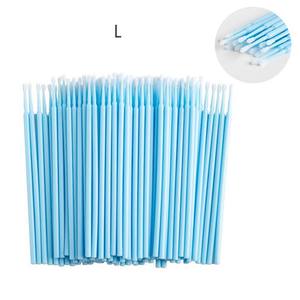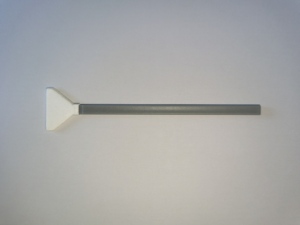(5046 products available)























































































































































































































Blue swabs, also known as cotton buds or q-tips, are small sticks with cotton pads on each end. They are commonly used for personal hygiene, such as cleaning ears, as well as for a variety of other purposes. There are several different types of blue swabs, including:
Overall, the different kinds of blue swabs are designed to cater to specific needs and preferences, offering various options for hygiene, beauty, and healthcare applications.
Choosing the proper type of cotton bud blue swabs entails determining what customers need them for and what kind of material they would require to do that task efficiently. There has been a shift from cotton bud swabs to silicone reusable ones. Although disposable options are still available, the market is leaning more toward sustainable products.
Usage
What customers intend to use the swabs for will determine which kind they will purchase. People might be using them for cleaning purposes, medical applications, or even arts and crafts. Some silicone swabs have different tips that can be used for various functions, such as one tip for cleaning electronic devices and another for ear cleaning.
Material Selection
The material used will also impact what kind swabs customers will choose. Those made with plush cotton will be suitable for applications requiring soft and absorbent qualities, while those made with firm cotton will be better for more robust applications. Foam tips might be more appropriate for applications requiring more significant cleaning capabilities.
Size and Shape
The size and shape of the blue swab will also impact the kind customers choose. Some might be longer and thinner, while others are shorter and more extensive. The size will depend on the application, as some might need to access tight spaces while others can work in more open areas.
Environmental Considerations
There has been a shift toward more environmentally friendly products due to increased awareness of plastic pollution and its impact on the environment. As a result, reusable silicone swab blue swabs are becoming more popular. Bulk buyers are looking for sustainable products they can market to environmentally conscious customers.
Although cotton pads have many uses in makeup application and beauty routines, there are some important things to remember when using them.
Eye Makeup
Blue applicator swabs are perfect for applying or removing eye makeup because of their precision. Using one end of the swab, gently apply the product to the desired area, such as the eyelid or lower lash line. The pointed end allows for accurate application, creating a defined look. If removing excess mascara or eyeshadow, use the other end of the swab to gently clean up any smudges or mistakes.
When working with eye makeup, be extra careful not to poke oneself in the eye. Always use a light hand and precise movements to avoid accidents.
Lip Makeup
For lip makeup, blue applicator swabs can help achieve perfectly defined lips. Use one end of the swab to apply lip color, lining along the edges of the lips for crisp definition. The other end can blend any harsh lines or uneven application, creating a smooth finish.
Keep in mind that lip makeup often contains more pigment than other makeup products, so be careful not to overapply or leave residue on the teeth from transfer.
Cleaning Up
Swabs are also great for cleaning up makeup mistakes. If there's a smudge of eyeliner or lipstick outside the lip line, use a cotton swab to gently correct it. The small size makes it perfect for getting into tight spaces around the eyes and mouth. Just dip the swab in a little makeup remover or water and wipe away the excess makeup.
Blue swabs are also handy for cleaning up makeup brushes and tools. Use them to reach small crevices on brushes and remove any buildup from makeup application. This helps keep makeup tools clean and ready for the next use.
Safety Precautions
While blue cotton swabs offer many conveniences and advantages in makeup application, it's important to keep safety precautions in mind. The small size and pointed ends of a cotton swab make it easy to poke or injure oneself if not handled carefully.
Always use a light hand when applying pressure with one end of the swab, as it could cause bruising or redness around delicate areas like the eyes and lips. Be especially cautious near the inner corner of the eyes, as this area is very sensitive and prone to damage.
Manufacturers design blue swabs with plastic or wooden sticks and cotton tips on both ends. Some may have foam or silicon tips instead of cotton. The foam or silicon material is usually more durable than cotton. The stick is usually about 6 inches long, while the tips are about 0.5 inches wide.
Blue Swabs have different features, functions, and designs, as outlined below:
Below are some functions of blue swabs:
Q1: What materials are used to make blue swabs?
A1: The materials used to make blue swabs vary depending on the type. Cotton is the most common material used for the tip, while the shaft can be made from plastic, wood, or paper. Some blue swabs are made with synthetic materials, such as nylon or polyester.
Q2: Are there a minimum order quantity (MOQ) for blue swabs?
A2: Yes, there is a minimum order quantity that varies depending on the manufacturer. The MOQ can be anywhere from 1,000 to 50,000 units, depending on the type of blue swab and the materials used to make it. Bulk orders attract better pricing and are favorable for wholesale business.
Q3: Are blue swabs biodegradable?
A3: Some blue swabs are made with biodegradable materials, making them more environmentally friendly. However, many are made with plastic or synthetic materials that are not biodegradable. Some manufacturers are producing blue swabs made from bamboo shafts and cotton tips to meet the demands of environmentally conscious consumers.
Q4: What are some emerging trends in the blue swab market?
A4: Some emerging trends in the blue swab market include sustainable and biodegradable swabs, innovative packaging, and customizable swabs for marketing and branding purposes. Other trends include varied sizes and swabs with unique features, such as stronger shafts and more absorbent tips.